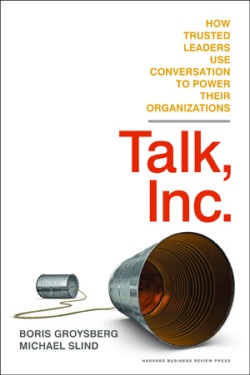Did Barack Obama win re-election because he was a better communicator than Mitt Romney? The 2012 race for president was so tight that it’s easy to speculate that this factor or that one made the crucial difference—and just as easy to dismiss all such speculation. But the communication factor merits a keen look. Both candidates, after all, waged this close-fought battle largely with words: Through their communication efforts, they each sought to forge a connection with voters.
Several weeks ago, we surveyed HBR.org readers to gauge their sense of each candidate’s ability to conduct and manage communication with voters. Both candidates, according to respondents, displayed an ability to communicate well. Yet the survey results indicate that Obama and Romney showed their respective strengths as communicators in very distinct ways.
We based our survey in part on a model that we call organizational conversation. In that model, leaders strive to practice and promote a form of communication that resembles personal conversation. Building upon our research on how leaders communicate today, we have identified four elements that make up this model: intimacy, interactivity, inclusion, and intentionality.
In the survey, which was open to HBR.org readers from September 21 to October 14, we asked respondents to rate how well each candidate performed along each of those four dimensions. Then we asked them to rate how well each candidate performed “overall” with respect to “conducting and managing communication with key constituencies.” In addition, we asked respondents to indicate whether they planned to vote for President Obama or Governor Romney.
Not surprisingly, respondents tended to answer our questions about each candidate’s performance in a way that reflected their candidate preference: Pretty much across the board, those who intended to vote for Obama gave their candidate higher marks as a communicator than they gave to Romney, and vice versa.
Nonetheless, we also observed an intriguing pattern that cuts across the line of candidate preference. Both Romney supporters and Obama supporters gave Romney higher scores on his overall communication performance than they did on any of the four areas of performance that we associate with the practice of organizational conversation. What’s more, on that question about “overall” performance, Obama supporters gave Romney essentially the same score that Romney supporters gave to Obama.
Those results, in our view, suggest that both sets of respondents attributed to Romney a talent for communication that differs substantially from the talent that Obama displayed. Obama excelled at pursuing a conversational form of political communication. So we argued previously in this space, and the results of our survey tend to support that conclusion. Romney, meanwhile, excelled at communicating with voters in what we might call a more traditional manner.
To understand what we mean by “traditional” in this context, consider Romney’s performance in the first presidential debate, held in Denver on October 2. In that venue, Romney was clear, cogent, and forceful. He knew what he wanted to say, and he said it systematically, using a tone and a rhetorical approach that he knew would appeal to his target audience. For decades, communicating in this model—communicating in a top-down and tactically efficient way—has been a central part of organizational leadership.
Thus, when respondents awarded Romney a relatively high score as an “overall” communicator, they were effectively recognizing his ability to convey messages in that traditional manner.
In business, as in politics, both of these forms of communication have their place. Leaders today, we believe, do benefit from the pursuit of organizational conversation. Nonetheless, we also appreciate the virtues of the more traditional model. Our model of organizational conversation, in fact, includes the element of intentionality precisely because that element addresses the need for clear, direct messaging. And, notably, both Romney supporters and Obama supporters gave Romney higher scores for that element than for each of the other three elements in our model.
In that first debate, Romney demonstrated an impressive ability to communicate intentionally with voters, and that performance gave his campaign a major boost during the final weeks of the race. (After the debate, interestingly enough, we noted a sharp rise in the number of Romney voters who responded to our survey—and a sharp rise, too, in the scores that Romney received from respondents as a whole.)
Obama, by most accounts, performed quite poorly in the Denver debate. In that setting, he seemed to many observers to be neither intimate nor interactive nor inclusive nor intentional. Over the course of the campaign as a whole, though, he seemed to draw effectively upon all four elements of organizational conversation—much as he and his team did in 2008. The results of our survey bear out that conclusion. Respondents scored Obama particularly high on the questions that pertained to intimacy and inclusion; even Romney supporters gave Obama relatively high scores in those areas.
Again, Obama’s prowess in this area—in conducting and managing communication to, from, and among voters—does not fully account for his victory. Even so, the success of his campaign this year highlights the power of the conversation-based model. Leaders in any kind of organization, we’d argue, are apt to benefit from adopting that model to communicate with key constituencies.
[Cross-posted, in a different version, at the Harvard Business Review Web site.]


google
/ 05/07/2013Hiya! I know this is kinda off topic but I’d figured I’d ask.
Would you be interested in exchanging links or maybe guest authoring
a blog post or vice-versa? My website discusses a lot of the same topics as yours and I think we could greatly
benefit from each other. If you happen to be interested feel free to send me an email.
I look forward to hearing from you! Fantastic blog by the way!